June 17th Scots Book of Days
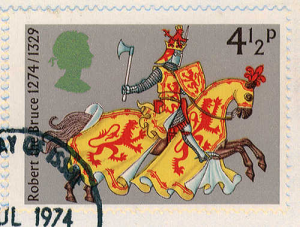 June 17 1219 David of Scotland, 8th Earl of Huntingdon died. David’s daughter Isabella, married Robert IV de Brus, 4th Lord of Annandale, by which marriage Robert acquired the manors of Writtle and Hatfield Broadoak, Essex in England. Huntingdon was the youngest surviving son of Henry of Scotland, 3rd Earl of Huntingdon and Ada de Warenne, a daughter of William de Warenne, 2nd Earl of Surrey, and Elizabeth of Vermandois. Wikipedia.
June 17 1219 David of Scotland, 8th Earl of Huntingdon died. David’s daughter Isabella, married Robert IV de Brus, 4th Lord of Annandale, by which marriage Robert acquired the manors of Writtle and Hatfield Broadoak, Essex in England. Huntingdon was the youngest surviving son of Henry of Scotland, 3rd Earl of Huntingdon and Ada de Warenne, a daughter of William de Warenne, 2nd Earl of Surrey, and Elizabeth of Vermandois. Wikipedia.
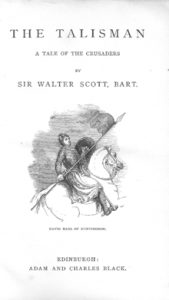 David of Scotland pictured in Sir Walter Scott’s 1832 crusader novel The Talisman. Although emphasizing his own story is fiction, Scott’s Introduction states that David did go on crusade with Richard the Lionheart “and was the hero of some very romantic adventures on his way home”. David is a possible inspiration figure for the Robin Hood legend because the legend plays at the same time as David lived in the 1190s. Another similarity as the Earl of Huntingdon question, a historian names Robin Hood as a possible Earl of that area. Also both had taken part in the Third Crusade and by 1194 David had taken part at the siege of Nottingham Castle where the High Sheriff of Nottinghamshire and Derby County was taken captive. His son Robert who died young was also a possible inspiration for Robin Hood.
David of Scotland pictured in Sir Walter Scott’s 1832 crusader novel The Talisman. Although emphasizing his own story is fiction, Scott’s Introduction states that David did go on crusade with Richard the Lionheart “and was the hero of some very romantic adventures on his way home”. David is a possible inspiration figure for the Robin Hood legend because the legend plays at the same time as David lived in the 1190s. Another similarity as the Earl of Huntingdon question, a historian names Robin Hood as a possible Earl of that area. Also both had taken part in the Third Crusade and by 1194 David had taken part at the siege of Nottingham Castle where the High Sheriff of Nottinghamshire and Derby County was taken captive. His son Robert who died young was also a possible inspiration for Robin Hood.
On August 22nd and 23rd 1877, Wilford Woodruff, later reported that three knights, among others, Sir Walter Scott ‘called upon me, as an Apostle of the Lord Jesus Christ, in the Temple at St. George, two consecutive nights, and demanded at my hands that I should go forth and attend to the ordinances of the House of God for them.’ A high honor indeed!
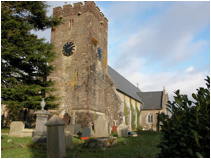 1239 Edward (later styled the 1st) born. Also known as Edward The Longshanks and The Hammer of the Scots, was King of England from 1272 to 1307.
1239 Edward (later styled the 1st) born. Also known as Edward The Longshanks and The Hammer of the Scots, was King of England from 1272 to 1307.
1282 Battle of Llandeilo Fawr.Tywi valley, Deheubarth, Wales. A short-lived victory over the English of Edward 1st King.
1314 Edward 2nd left Berwick-upon-Tweed on 17 June 1314 with between 2,000–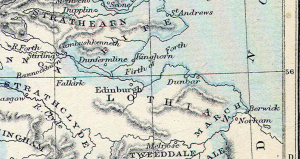 3,000 horse (likely closer to 2,000) and 16,000 foot, at least two or three times the size of the army Bruce had been able to gather.
3,000 horse (likely closer to 2,000) and 16,000 foot, at least two or three times the size of the army Bruce had been able to gather.
Brus or Bruce 1050 2Stewart2 Kennedy 2 Montgomery2 Blair 2Cochrane2 Miller 2Simmons2Choate zoe ToaG Map showing Scotland circa 1285 with Berwick on the east coast on the river Tweed. Edward’s army will follow the Lothian coastline west toward Dunbar, past Edinburgh, up the Firth of Forth, heading to Stirling, but passing first thru Bannockburn near the River Forth. The Strathclyde drains west thru the River Clyde. Notice Tweeddale collects the headwaters of the River Tweed which drains east to the North Sea in the March.
1390 Wolf of Badenoch burns Elgin Cathedral. Third son of King Robert II, Stewart, the Wolf was Alexander Stewart, Alisdair Mor mac an Righ, known as Big Alexander, Alexander Senescalli (Latin for Steward), or after his death, the Wolf of Badenoch. Throughout his life he was Lord of Badenoch around 1371, and 1st Earl of Buchan (or Buchanan) and was also his brother’s royal deputy in the north of Scotland. Alexander’s wife, Countess of Ross, was deserted by him. His wife appealed to the Bishop of Moray, who unfortunately for him, gave judgment in her favour.
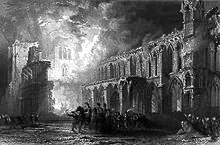 19th century depiction of the burning of Elgin Cathedral. Alexander’s destruction of the church possessions in Elgin was complete—as well as the cathedral, the monastery of the Greyfriars, St Giles parish church and the Hospital of Maison Dieu were all put to flame.
19th century depiction of the burning of Elgin Cathedral. Alexander’s destruction of the church possessions in Elgin was complete—as well as the cathedral, the monastery of the Greyfriars, St Giles parish church and the Hospital of Maison Dieu were all put to flame.
Alexander was outraged. All out for revenge, he came down from his stronghold, the castle of Lochindorb and ransacked and burned Forres and Elgin. Elgin of course, being the ecclesiastical centre of the Bishopric of Moray. Setting off fires, mainly in the College, the Canon’s houses and the Hospital of the Maison Dieu, he terrified the people of Elgin, forcing them to flee with their families into the countryside.
In 1390 he burned Elgin Cathedral, destroying many of its records including family, legal and monastic – irreplaceable. A terrible loss.
The Wolf was called upon by his father to do penance for this heinous crime. This he did under the watchful eye of his father the King, nobles and many dignitaries of the church. The King, believing that his son had learnt his lesson, finally pardoned him, and he was received back into the Church.
Legend has it that The Wolf of Badenoch died in 1394, although others maintain it was in 1406, when it is believed that he played chess with the devil. He had been visited at Ruthven Castle by a man, who was tall, and dressed in black. The man wished to play a game of chess with the Wolf. The game went on for several hours until the tall, darkly dressed man moved one of the chess pieces and called ‘check’ and then ‘checkmate’. The man rose from the table. On calling these words there was a terrible storm of thunder, hail and lightening.
Wolf of Badenoch2 Sutherland2 Sinclair2 Stewart2 Ruthven2 Ruffin2 Kinchin2 Jarrett2 Jared2 Simmons2 Choate2 Jacob Summers.
1528 title in the Peerage of Scotland created on 17 July 1528 by King James V of Scotland for his stepfather Henry Stewart, 1st Lord Methven and Methven Castle.
Stewart Lord Methven1525 1020 Henry 1st2 Ruthven2 Kinchin2 Jared2 Simmons2 Choate2 Zoe
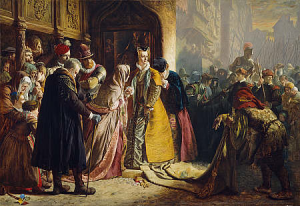 1567 The Return of Mary Queen of Scots to Edinburgh. Artist James Drummond 1870. Drummond portrayed Mary’s subsequent departure from Edinburgh at sunset on 17 June 1567 to be incarcerated in the island fortress of Lochleven Castle. She is shown encountering the banner with its hostile slogan, accusing her of Darnley’s murder. Drummond does not reveal his own attitude, but suggests by means of Mary’s fallen glove (a glove or gage required a champion to pick it up and fight in its defense) the enigma and challenge which her story still poses. www.nationalgalleries.org
1567 The Return of Mary Queen of Scots to Edinburgh. Artist James Drummond 1870. Drummond portrayed Mary’s subsequent departure from Edinburgh at sunset on 17 June 1567 to be incarcerated in the island fortress of Lochleven Castle. She is shown encountering the banner with its hostile slogan, accusing her of Darnley’s murder. Drummond does not reveal his own attitude, but suggests by means of Mary’s fallen glove (a glove or gage required a champion to pick it up and fight in its defense) the enigma and challenge which her story still poses. www.nationalgalleries.org
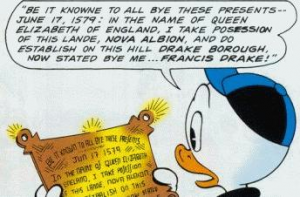 1579 Sir Francis Drake later left the settlement he left a brass plaque, to prove his claim on the area, with the following inscription: a fictional Malcolm McDuck was the first mate of “The Golden Hind” when Drake sailed the west coast of America, and that the same Malcolm McDuck was later put in charge of the first garrison in Fort Drakeborough. He thus became the first commander of the fort and also the very first McDuck in fictional Duckburg, 323 years before $crooge first arrived there in 1902. When asked about the relation between this Malcolm McDuck and the “Matey” McDuck.
1579 Sir Francis Drake later left the settlement he left a brass plaque, to prove his claim on the area, with the following inscription: a fictional Malcolm McDuck was the first mate of “The Golden Hind” when Drake sailed the west coast of America, and that the same Malcolm McDuck was later put in charge of the first garrison in Fort Drakeborough. He thus became the first commander of the fort and also the very first McDuck in fictional Duckburg, 323 years before $crooge first arrived there in 1902. When asked about the relation between this Malcolm McDuck and the “Matey” McDuck.
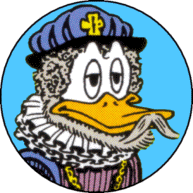 Sir Francis Drake (Circa 1540-1596). The Drakes descend from fictional clan McDuck. Even though England and Scotland were still separate nations back in 1579 there is no problem in including a Scotsman like Malcolm McDuck in Drakes crew. Sailing for foreign nations was normal. duckman.pettho.com/history
Sir Francis Drake (Circa 1540-1596). The Drakes descend from fictional clan McDuck. Even though England and Scotland were still separate nations back in 1579 there is no problem in including a Scotsman like Malcolm McDuck in Drakes crew. Sailing for foreign nations was normal. duckman.pettho.com/history
1633 William 11th earl of Angus, created 1st Marquis of Douglas, by Charles 1st, Anderson Scot’s History v. 2/p. 48
1755 Battle of Monongahela River 1755 – Braddock’s Defeat, Fort Duquesne, western Pennsylvania Colony. The French and Indian War also known as the Seven Year War (1757 to 1762).
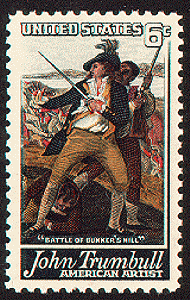 1775 – Battle of Bunker Hill, a battle American War of Independence fought near the hill in Charlestown, Massachusetts.
1775 – Battle of Bunker Hill, a battle American War of Independence fought near the hill in Charlestown, Massachusetts.
1968 October 18, “Detail from The Battle of Bunker’s Hill, John Trumbull”, Son of the governor of Connecticut, he was the first native born American to dedicate himself to painting. He was an aide-de-camp to George Washington in the Revolutionary War. Trumbull’s hopes of being the nation’s official history painter were stymied until 1817, when the U.S. Congress commissioned him to paint four scenes from the war for the Capitol rotunda. In that same year, he was named director of the American Academy of Fine Arts in New York City. usstampgallery.com
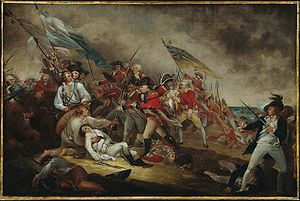 The Death of General Warren at the Battle of Bunker Hill by John Trumbull. The painting shows the fallen American general Warren about to be killed by a British soldier, it also highlights another British soldier holding his fellow soldier back, preventing him from bayoneting Warren. At right center, in the background, less visible, British Major Pitcairn falls into the arms of his son. [Pitcairn clan] However, it contains several errors and anachronisms. No known picture of Major Pitcairn survives. Another son, Dr. David Pitcairn (1749–1809) was used as a model by Trumbull. The uniform depicted was not adopted by the Marines until the 1780s. Pitcairn is shown falling at the bunker at its capture from the American force, but he was shot while starting the ascent of the hill. When the first assaults failed, Pitcairn led his men up the hill toward the American position, only to fall to a rifle shot, said to have been fired by a black former slave named Peter Salem. Pitcairn toppled into the arms of his son, William, also a Royal Marine, who cried, “I have lost my father!”
The Death of General Warren at the Battle of Bunker Hill by John Trumbull. The painting shows the fallen American general Warren about to be killed by a British soldier, it also highlights another British soldier holding his fellow soldier back, preventing him from bayoneting Warren. At right center, in the background, less visible, British Major Pitcairn falls into the arms of his son. [Pitcairn clan] However, it contains several errors and anachronisms. No known picture of Major Pitcairn survives. Another son, Dr. David Pitcairn (1749–1809) was used as a model by Trumbull. The uniform depicted was not adopted by the Marines until the 1780s. Pitcairn is shown falling at the bunker at its capture from the American force, but he was shot while starting the ascent of the hill. When the first assaults failed, Pitcairn led his men up the hill toward the American position, only to fall to a rifle shot, said to have been fired by a black former slave named Peter Salem. Pitcairn toppled into the arms of his son, William, also a Royal Marine, who cried, “I have lost my father!” 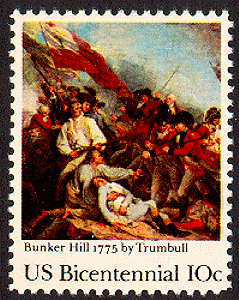 Some of the British Marines tried to console the young officer, while others, overcome with emotion, moaned. Pitcairn was carried back to Boston, and died of his wound within hours. PITCAIRN is buried at the Old North Church in Boston.
Some of the British Marines tried to console the young officer, while others, overcome with emotion, moaned. Pitcairn was carried back to Boston, and died of his wound within hours. PITCAIRN is buried at the Old North Church in Boston.
1975 June 17. John Trumbull’s famous painting of the Battle of Bunker Hill depicts Warren’s death.
1959 June 17. Liberty issue. When Americans learned that the British in Boston had planned to take certain heights outside the city, Gen. Artemas Ward ordered the fortification of Bunker Hill on the Charlestown peninsula. 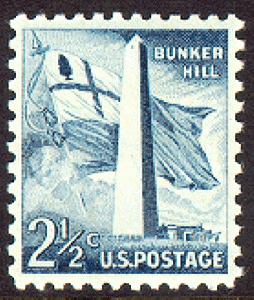 His subordinates, without explanation, took positions on the nearby Breed’s Hill. The British launched an attack on the hill, and in several hours the Americans were forced to give up their positions. The British dead and wounded accounted for more than 1,150 of 2,500 men in the battle. For the 50th anniversary an obelisk was erected. usstampgallery.com
His subordinates, without explanation, took positions on the nearby Breed’s Hill. The British launched an attack on the hill, and in several hours the Americans were forced to give up their positions. The British dead and wounded accounted for more than 1,150 of 2,500 men in the battle. For the 50th anniversary an obelisk was erected. usstampgallery.com
1814 Robert Grant (astronomer) (17 June 1814 – 24 October 1892) was a Scottish astronomer. 1852 published his book The History of Physical Astronomy from the Earliest Ages to the Middle of the Nineteenth Century. The work immediately took a leading place in astronomical literature and won for Grant the 1856 Gold Medal of the Royal Astronomical Society.
1829 Joseph Smith the Prophet, at Fayette, Seneca county, New York, (clans Huntley, Hamilton, Mackenzie, Mack of Inverness, Malcolm King of Scots). Doctrine and Covenants 15. Sometime in June. ‘Declare repentance unto this people,’
1938 Polar Trappers is a 1938 Donald Duck and Goofy cartoon in the South Pole trapping polar animals. This is the first cartoon that Donald Duck and Goofy appear in without Mickey Mouse.
1943 Newt Gingrich, born Newton Leroy McPherson (clan McPherson); June 17, 1943, American Speaker of the House of Representatives from Georgia, 1995 to 1999. B.A. degree in history from Emory University in Atlanta in 1965. He then proceeded to earn an M.A. (1968) and Ph.D. (1971) in modern European history, both from Tulane University in New Orleans.
Disclaimer: The author of each article published on this web site owns his or her own words. The opinions, beliefs and viewpoints expressed by the various authors and forum participants on this site do not necessarily reflect the opinions, beliefs and viewpoints of Utah Standard News or official policies of the USN and may actually reflect positions that USN actively opposes. No claim in public domain or fair use. © John Choate
Utah Standard News depends on the support of readers like you.
Good Journalism requires time, expertise, passion and money. We know you appreciate the coverage here. Please help us to continue as an alternative news website by becoming a subscriber or making a donation. To learn more about our subscription options or make a donation, click here.
To Advertise on UtahStandardNews.com, please contact us at: ed@utahstandardnews.com.


Comments - No Responses to “June 17th Scots Book of Days”
Sure is empty down here...